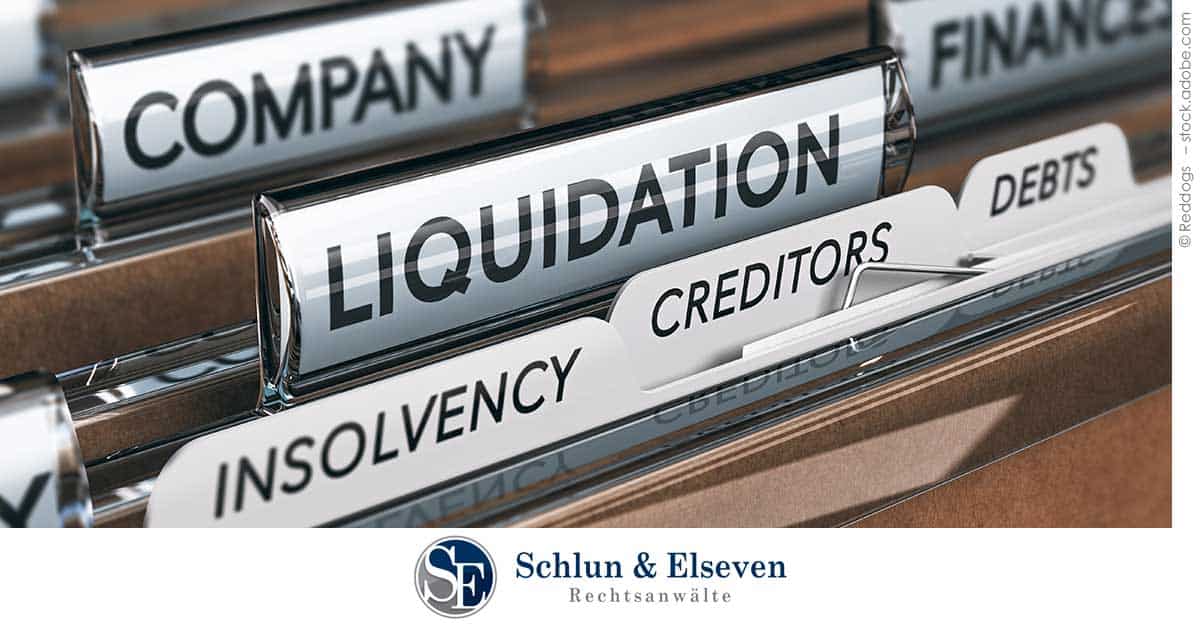The protective shield proceedings is a means by which firms can restructure their business in the face of likely insolvency. As long as the insolvency in question is still “pending” and not yet taking place, it can be possible for firms to enter protective shield proceedings. Such proceedings allow the debtor to have some control over the company, with supervision from the insolvency court, and they can make decisions on the company itself. This article will examine what is involved in protective shield proceedings, and we will outline the options available to companies.
At Schlun & Elseven, our German insolvency lawyers advise clients from all over Germany on their options in insolvency proceedings. We have previously written about Insolvency Law and COVID-19 Coronavirus and other articles on the topic. We also provide advice on corporate restructuring and thus can provide your company with the support you may need at difficult times. Contact us today using the contact form below this article to hear from our insolvency lawyers directly.
The Legal Basis for Protective Shield Proceedings in Germany
The protective shield proceedings are modelled on the US model of the “Chapter 11 Proceedings”. Under this form of proceedings, it is encouraged that the company seeks to undergo restructuring rather than go into traditional insolvency proceedings. The hope is that such restructuring will allow the company to continue and, if successful, will prevent full job losses and the company itself collapsing. It is supervised by the Insolvency Court to ensure that the protective shield proceedings are carried out appropriately.
§ 270b (1) InSO provides for protective shield proceedings, and it states:
(1) If the debtor has made his request for the opening of insolvency proceedings on account of imminent insolvency or overindebtedness… and if the intended restructuring does not manifestly lack the prospect of success, the insolvency court shall… set a deadline for submission of the insolvency plan. The deadline may not exceed three months. The debtor shall enclose with the request certification, with grounds, provided by a tax advisor, accountant or lawyer with experience in insolvency matters or a person with comparable qualifications which provides evidence of the imminent insolvency or overindebtedness but that the debtor is not already insolvent and that the intended restructuring does not manifestly lack the prospect of success.
Here we can see that for protective shield proceedings:
- The debtor must request it,
- Insolvency is imminent but not yet in process,
- An experienced professional must oversee it,
- There must be an insolvency plan and some chance of success in the restructuring.
During the protective shield proceedings, the debtor still has a degree of control as the process is under self-administration. Here the debtor can decide on the insolvency plan, but there will be an Insolvency Court-appointed representative who will oversee how the process is carried out.

If you have a particular issue or legal question concerning German Insolvency Law, you can contact our law office anytime. Our lawyers for German Insolvency Law can be reached by phone, email and also provide video conferencing options. For more legal information, please visit our Insolvency Law Homepage.
Self-Administration
Self-administration is one of the main advantages of protective shield proceedings. In self-administration, the company management has a degree of control over the process. The Insolvency Court will appoint a trustee/custodian to oversee and advise on the procedure, but they are not in complete control of the handling of the assets. This is different to more traditional proceedings. However, the insolvency trustee does have the right to challenge transactions made by the company at this time.
Self-administration is granted only in situations where the court believes that self-administration will not endanger the rights of creditors. Working with an experienced insolvency lawyer will provide guidance when applying for self-administration and the protective shield proceedings.
Self-administration is not granted indefinitely, and it can be revoked. If creditors decide to have a motion to remove the right of self-administration at a creditors’ meeting, it can be revoked. It is crucial to have the right advice available and coordinate with the different stakeholders when restructuring the company.
The aim of self-administration, protective shield proceedings, and restructuring is that the company can emerge again. Self-administration should provide a degree of flexibility that may be more suitable to the nature of the company. Obviously, plans that are deemed to be excessively risky may be flagged by the creditors or the trustee /custodian. Working with creditors and the other stakeholders can lead to solutions suitable to all parties.
By not going straight into insolvency proceedings, the company may be able to save itself and thus provide its creditors with improved terms following its restructuring. For creditors, this is why such self-administration / protective shield proceedings can be of benefit to them.
Stages of Restructuring
To prepare your company for the protective shield proceedings, it is necessary to know what is involved at each stage of the proceedings. Here is an outline of how it looks in practice.
Preparation
Make sure the company is not already insolvent. Protective shield proceedings under § 270b InSO cannot be applied for. Work out if the insolvency is imminent and how long it should be until insolvency appears inevitable. Work with an experienced professional in the field of insolvency law for this matter, as by doing so, your company can better determine when to start the protective shield proceedings.
Planning and Applications
Once the decision has been made to restructure the company, the planning can officially start. Here our lawyers will analyse and assess your company. From this analysis, we can make decisions as to how to restructure the business. Such analysis will consider risk factors and look for ways by which such risk can be mitigated. We will closely monitor the steps taken to implement such proposed changes.
Once our route is decided upon, we will work with your company and coordinate with creditors and other stakeholders. Having milestones and targets in place will ensure that the restructuring can be assessed on a tangible level. Any issues raised by stakeholders or creditors can then be assessed with these set targets and milestones in mind.
The debtor generally has a maximum of three months to submit their insolvency plan. Self-administration is allowed with the aim that the plan will be submitted in good time.
Insolvency Court Proceedings
The insolvency court will monitor the restructuring. During this time, the court-appointed custodian will observe and oversee the actions taken by the debtor company. Creditors may also have oversight as to the actions taken by the company, as management seek to carry out the plans made. During the main proceedings, the court seeks to oversee “healthy shrinking”, whereby the company looks to exit contracts that are unfavourable to it.
Employees are protected by insolvency money during this time. This lasts for three months. Employment contracts are not automatically terminated, but plans can be made at this point to put employees on notice if appropriate to the restructuring plan. Some employee rights can be limited during this time.
Should the company enter protective shield proceedings, the Insolvency Court can grant protective measures that restrict creditors’ attempts to invoke enforcement measures. However, as we will see below, should the insolvency plan not be deemed sufficient or if the case is deemed “hopeless”, the protective shield can be removed.
Implementing Insolvency Plan
Should the plan have been agreed upon and the creditors favour it, the insolvency plan can be implemented. At this point, creditors will have a creditors meeting and determine their support, or lack of it, at this stage. Creditors’ claims are also examined, established and contested during this meeting. The insolvency plan will determine the distribution of appropriate company assets.
Exiting Protective Shield Proceedings
Once the assets have been distributed appropriately and the plan has been followed, steps can now be taken to exit the protective shield proceedings. The court will order the release of the company from the proceedings. It should be noted that in most cases, creditors do not receive the full amount of what they are owed. As a creditor, it is recommendable to consult with parties who know what to expect in such insolvency proceedings.
Termination of Protective Shield Proceedings and Self-Administration
Protective shield proceedings and the self-administration of insolvency is not an unlimited right. There are circumstances when it can be removed. As stated earlier, if the actions taken endanger the rights of creditors, steps can be taken at creditors’ meetings to prevent the debtor’s restructuring plan. The level of creditor and their rights will play a role in determining how strong their voice is in the creditors’ meeting.
It can also be terminated where saving the company in this manner is deemed to be “hopeless“. The insolvency court, through its custodian, does have oversight of how the company is managing self-administration. This is where not reaching milestones and taking unnecessary risks can cause difficulties for the debtor company.
Our Services: Protective Shield Proceedings in Germany
Our lawyers will go through the entire procedure with you, regardless of whether you come to us as a debtor or a creditor. An organised approach to the different stages, while outlining what is expected at each stage, ensures that we remain on the same page and that communication is open.
- Debtors Advice: our legal professionals will analyse your business and work with you in determining whether your company should enter protective shield proceedings.
- Certification for Protective Shield Proceedings: our lawyers are very familiar with insolvency proceedings. We can assess your company and prepare it for the certification for insolvency protective shield proceedings. Grounds are needed to award such a certification, and should your company fulfil the requirements, we can justify that certification.
- Corporate Restructuring: we are experienced in the field of corporate restructuring. From analysing your company, we can provide the basis of what steps need to be carried out with corporate restructuring. With our lawyer’s advice, you provide yourself with an improved likelihood of saving the company. We will help you to draft restructuring plans acceptable to the parties involved in the insolvency proceedings.
- Legal Proceedings: Deadlines and Paperwork: our insolvency lawyers will ensure that deadlines are met, and paperwork is filed appropriately and on time. We have many years of experience with the Insolvency Court and, therefore, can advise you on an appropriate custodian to oversee the protective shield proceedings.
- Coordinating with Creditors and Other Stakeholders: successfully navigating the restructuring needed in protective shield proceedings involves coordinating with creditors and other stakeholders. We will ensure that concerned parties are kept up-to-date with steps taken by the debtor company during the restructuring stage. Keeping the different parties on your side is important at this point. With their support, the likelihood of successful restructuring is increased.
- Advising Creditors: we do not exclusively work with debtors. With creditors, we use our in-depth knowledge of insolvency proceedings to ensure that your interests are protected during such proceedings. We will help protect your rights and represent your best interests in such matters.
The above listed are just some of our services in this field. For further information about our services in this field, don’t hesitate to get in touch with us directly using our contact form.
Insolvency Lawyer in Germany
At Schlun & Elseven Rechtsanwälte, our insolvency law team works with clients from all over Germany and further afield when navigating the German legal system. We advise debtors and creditors in their options for insolvency proceedings and ensure that they are familiar with what is involved in the process. Our offices are located in Cologne, Düsseldorf and Aachen, and we have further conference facilities in other major cities across the country. We can also coordinate with clients from a distance through email, phone and video conferencing. We can be contacted initially through our contact form below this article.
Regardless of which side you are approaching the protective shield proceedings or the insolvency issue, our lawyers can advise you on how to proceed. Contact us today to find out more about how we can help you.


